THE CLASSIC HORROR FILM
By Jeffrey-Baptiste Tarlofsky
By Jeffrey-Baptiste Tarlofsky
Lesson 19 consists of 8 video lectures and transcripts of those lectures, and 8 film excerpts. Start with the lecture, Part 1, and continue down the page in sequence until you reach the end of the lesson.
レッスン19は8本のビデオレクチャー(レクチャーのテキストがビデオレクチャーの下に記載されています)と8本の動画で構成されています。
このレッスンは、ページをスクロールダウンしながら最初から順番に動画を見たりテキストを読んでください。
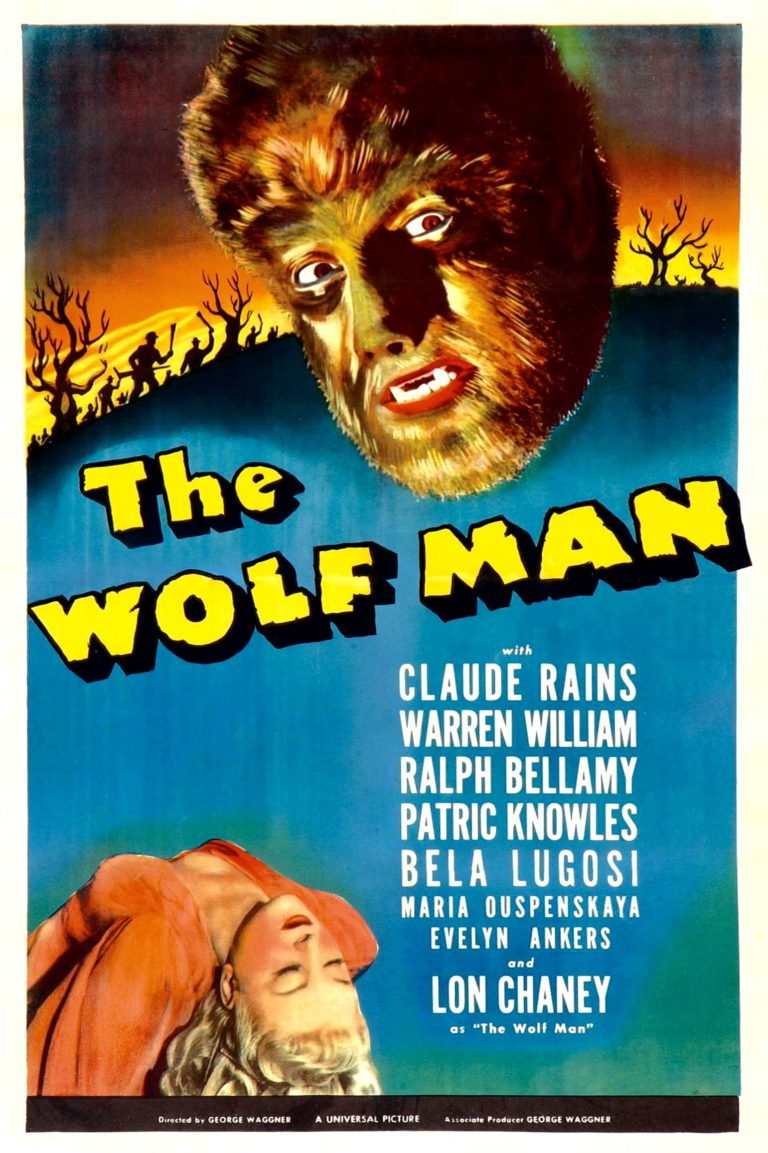
Directed and Produced by George Waggner
Written by Curt Siodmak
Starring Lon Chaney, Jr., Bela Lugosi, Evelyn Ankers, Claude Rains, Ralph Bellamy, Maria Ouspenskaya
Distributed by: Universal Pictures
Budget: $180,000
Running Time: 70 minutes
Part 1 – The Wolf Man is the best horror film Universal produced in the 1940s and yet it completely fails to meet the Thalberg formula’s three requirements for a successful film. Unlike The Hunchback of Notre Dame, The Phantom of The Opera, The Man Who Laughs, Dracula and Frankenstein, The Wolfman does not have high production values as it was made on an even lower budget than Dracula or Frankenstein; the director, George Waggner, was not nearly as talented as Tod Browning or James Whale. However, the film did have the name of a great star for its leading man, none other than Lon Chaney! But, you protest, Lon Chaney died in 1930. Correct. The star of the film was his son, Creighton Chaney who changed his name to “Lon” for this film (and did not add the “Jr”). Of course, this is another example of the power of the brand. If he had been just “Creighton Chaney” his name would not have attracted the attention of audiences. But being both the son of the great Lon Chaney Sr. and having his name got him the starring role. Finally, the film is not based on a famous novel even though there had quite recently been a very successful novel about a werewolf, The Werewolf of Paris (1933), which was the #1 bestseller on the New York Times list of books for 1933.
There was a very good reason why Universal did not buy the rights to this novel and turn it into a film. The author of the novel, Guy Endore, was a member of the Communist Party of the U.S.A. and his works were under sanction by the Catholic Church. The Catholic Church and the Communist Party were, of course, mortal enemies. So any attempt to film one of Endore’s novels would have been heavily censored by Joseph Breen, the fanatical Catholic president of the P.C.A.. Universal had made that decision back in 1935 when the studio first attempted to make a werewolf film. The film was called The Werewolf of London. Obviously Universal was trying to attract audiences who had read the book, The Werewolf of Paris, without actually paying for the rights or using the story from the book. Have a look at the trailer for the film here.
The Werewolf of LondonPart 2 – You can certainly understand why the film was a failure just by watching the trailer. If the trailer is boring, you know the film will be! The Werewolf of London (1935) is the only Universal horror film of the classic period 1923-1936, other than The Man Who Laughs (1928), to actually lose money. The film suffered badly from a confusing and not very interesting story as well as the decision by the star, Henry Hull, not to use the make-up designed by Jack Pierce for the werewolf. Pierce was forced to change the makeup so that the audience could recognize Hull’s face.
Jack Pierce would have his revenge six years later when his original makeup design was used successfully in The Wolf Man for Lon Chaney’s werewolf.
While Henry Hull was probably a better actor than Lon Chaney Jr., he had a less interesting character to play in his film. Chaney’s character, Lawrence Talbot, on the other hand, was as tragic in many ways as Lon Chaney Sr.’s monsters.
When Universal started making horror films again in 1939, they began with the previously mentioned third Frankenstein film, Son of Frankenstein. But while these sequels were moneymakers, Universal believed they also needed to explore new ideas. The Wolf Man is not a sequel to The Werewolf of London. Remember that Hollywood only makes sequels of films that make money. The Wolf Man is a combination of something old and something new. It is what the industry calls a “reboot”. A reboot is a film that takes either a basic story, character, or idea and builds a new film around it. Examples of contemporary reboots include the Spiderman films and Batman films. Hollywood increasingly depends on reboots as much as it does on sequels. The Wolf Man is arguably the first actual Hollywood reboot. The film takes the basic character, a werewolf, but tells a completely new story about that character.
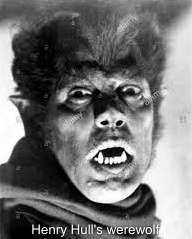
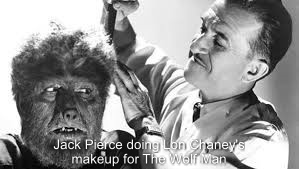
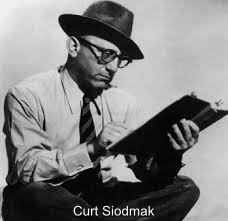
As previously mentioned, the Thalberg formula was not used in making The Wolfman. The film is neither based on a great novel nor does it have a great star in the film (it does have a great star’s name for marketing purposes, but Lon Chaney Jr. was not a third the actor his father was). Nor is the production up to the quality of either Frankenstein or Dracula as the director, George Waggner, was not close to being as talented as James Whale or Tod Browning. The key to the film’s success was completely due to the original screenplay produced by Curt Siodmak. Screenwriters are the people who write the actual scripts for films. Very often their job is to adapt a novel for a film. The novels Dracula and Frankenstein were both adapted by screenwriter, John Balderston. But sometimes screenwriters are asked to create completely original stories and this is what Siodmak did for The Wolfman. Siodmak was certainly the right man for the job.
Born in Germany in 1901, Siodmak started his career as a novelist but soon became involved in the German film industry as a screenwriter. Siodmak was Jewish-German and by 1931-32 he became afraid that the Nazis might come to power in Germany. He left just before Hitler took power. Siodmak first went to London and then made his way to Hollywood in 1937 where he became a screenwriter for Universal. The Wolfman was his first great success.
 Part 3 – The film begins with someone opening an important-looking medical book and looking at the definition of “lycanthropy”, which is described as a mental illness in which a person believes him or herself to be a wolf. This is the first time in a Universal horror film that a psychological explanation for monstrosity is used. Dracula was a purely supernatural monster and the Frankenstein monster was created by scientific means. But Siodmak introduces the idea that “the monster” might just be someone believing they are a monster.
Part 3 – The film begins with someone opening an important-looking medical book and looking at the definition of “lycanthropy”, which is described as a mental illness in which a person believes him or herself to be a wolf. This is the first time in a Universal horror film that a psychological explanation for monstrosity is used. Dracula was a purely supernatural monster and the Frankenstein monster was created by scientific means. But Siodmak introduces the idea that “the monster” might just be someone believing they are a monster.
Lawrence (Larry) Talbot is the second son of Sir John Talbot of Talbot Castle. Siodmak introduces another psychological element to the story by letting us know that Larry and Sir John have had problems in their relationship in the past. Larry has only returned because now that his older brother is dead he is the heir to the castle and the title when his father dies.
Sir John is an astronomer and his son an engineer so they share an interest in the new telescope Sir John has just had delivered. In the next excerpt, we see that while testing the refractor of the telescope Larry accidentally looks into the bedroom of a local woman from the village.
Part 4 – Recall that in Dracula, Dracula enters the bedrooms of women he is going to attack at night while they are asleep, and also that in Frankenstein the monster attacks Elizabeth on the day of her wedding in a bedroom where she is getting dressed. Larry has “invaded” Gwen’s bedroom with his telescope. Accident it may be, but it is actually a crime in many countries to do this. It is called being a “peeping Tom” and the maximum penalty for committing this act in the United States is six months in jail. More obviously, Larry should simply not be doing this because it is wrong, yet he seems to feel entitled to invade her privacy…perhaps because he is the son of the local nobleman? He learns that she lives above her father’s antique shop and goes there the next day.
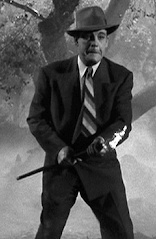
He isn’t interested in antiques or werewolves, just this attractive young woman. However, he chooses a walking stick to purchase just to make her happy. It happens to be a wolf’s head walking stick with a pentagram. More importantly, it is made of silver (which we learn later in the film is the only thing that can kill a werewolf). I myself have a wolf’s head walking stick (see my video lecture) because…well… you never know.
Larry listens to Gwen recite the poem :
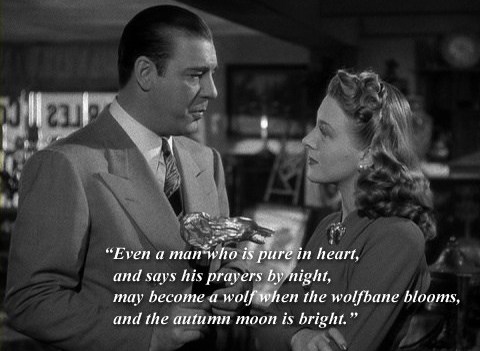
Part 5 – Gwendolyn uses a trick many intelligent women have used when they go out with a man they do not know well for the first time. She invites her friend, Jenny, to join them. This isn’t what Larry hoped for, but he takes both women to the gypsy camp to have their fortunes read. Once there they meet the gypsy, Bela, who is played by none other than the great Bela Lugosi (who has sadly been reduced from playing star roles to playing second-tier characters).
As Jenny goes into Bela’s trailer, Larry suggests that Gwendolyn take a walk with him. I believe the look she gives him is something we have never really seen before in a horror film. Gwendolyn was played by Evelyn Ankers who was a considerably more talented actress than any who played female leads in any of the Dracula or Frankenstein films (except for the wonderful Gloria Holden who played Dracula’s daughter).
She gives Larry a sultry look, glances in Jenny’s direction, and then walks off with him into the forest where he says he will “tell her fortune”. It has to be one of the most sexually suggestive looks any actress gives in any horror film of the time. Remember, female characters in horror films were mainly there to scream when the monster tries to get them. In fact, I think Ankers was doing something quite interesting with that look. Siodmak’s script has her telling Larry, “I really shouldn’t be here”, but that look already told Larry she was aware of why he asked her to walk into the forest with him. This is what we call a “mixed message” and people are always sending mixed messages to each other…but they don’t usually do it in films unless the director specifically wants his actors to do so. It seems to me that the director, George Waggner, didn’t direct Ankers to give such a look, she did it on her own as a way of making her character a little less innocent and a little more interesting.
However, she does tell Larry that she is engaged to be married, which means that, indeed, she really shouldn’t be out with him alone in the forest at night. An engagement was a promise of marriage and it was understood that once an engagement was made both parties would no longer see other people. Now they have both broken the rules of propriety: Larry by watching Gwen in her bedroom, and Gwen by going out with Larry when she is already engaged.
There are grave consequences for Larry and Gwen’s rule-breaking. They have left Jenny alone with Bela and Bela is a werewolf. Although Bela himself does not want to harm Jenny, once he transforms into a wolf, he cannot stop himself and chases her down and attacks her. Hearing her screams, Larry tries to rescue Jenny, but it is too late, Bela has killed her. He then attacks Larry who uses his silver wolf’s head cane to kill the “wolf”, (and now you know why I have a silver wolf’s head cane…just in case …just in case).
Larry has been bitten by a werewolf and lived. Werewolves make other werewolves much the same way vampires make new vampires, by biting them.
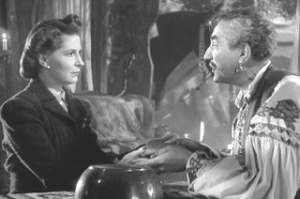 However, (by the usual rules), a vampire would have to let the victim drink his blood in order to make them a vampire. Vampires decide who to make a vampire. However, when someone changes into a werewolf, they are totally irrational and only want to kill. It is always an accident when a werewolf only wounds someone. Then that person becomes a werewolf, too. In some cases, such as Lestat and Louis, the vampire may give their victim a choice as to whether they wish to become a vampire. But no werewolf ever chooses to become a werewolf. Thus again:
However, (by the usual rules), a vampire would have to let the victim drink his blood in order to make them a vampire. Vampires decide who to make a vampire. However, when someone changes into a werewolf, they are totally irrational and only want to kill. It is always an accident when a werewolf only wounds someone. Then that person becomes a werewolf, too. In some cases, such as Lestat and Louis, the vampire may give their victim a choice as to whether they wish to become a vampire. But no werewolf ever chooses to become a werewolf. Thus again:
Even a man who is pure in heart
And says his prayers by night
May become a wolf when the wolfbane blooms
And the autumn moon is bright
Saying your prayers…being good, can’t save you if you have had the bad luck to be bitten by a werewolf and live. You are cursed.
Part 6 – For Gwendolyn, the consequences of her actions are that she blames herself for Jenny’s death and so do some of the villagers, including Jenny’s mother. Larry’s entrance and angry demand to hear what more the women have to say obviously frightens them, but the fear is not just because Larry is a big angry man with a heavy walking stick. It is one thing to make remarks about an antique dealer’s daughter, it is quite another to make those same remarks about the son of the local nobleman. Just as no one in the village where his father was the Baron dared to directly accuse Dr. Frankenstein of wrongdoing, neither can anyone really accuse Larry in the village where Sir John is obviously the richest and most powerful man in the village. But Siodmak would seem to be suggesting that the reason Jenny died was because Larry failed to carry out his duties as her protector. Having taken both the young women into the forest, Larry was also supposed to protect both of them. Instead, because he was off with Gwendolyn trying to develop a forbidden romance, Jenny was left alone and unprotected with Bela.
 While Gwendolyn struggles with her guilt over Jenny’s death, Larry starts to have terrible dreams at night and strange thoughts during the day. A local villager is killed one night by what everyone thinks is a wolf. The next day, Larry finds his window open and his bare feet covered in dirt and his clothes torn. Moreover, the animal tracks lead directly to the castle.
While Gwendolyn struggles with her guilt over Jenny’s death, Larry starts to have terrible dreams at night and strange thoughts during the day. A local villager is killed one night by what everyone thinks is a wolf. The next day, Larry finds his window open and his bare feet covered in dirt and his clothes torn. Moreover, the animal tracks lead directly to the castle.
Seeking an answer to what is wrong with him, he again goes to the gypsy camp where he meets Bela’s mother, Maleva. Larry is horrified by what she tells him and unwilling to believe her. But the evidence is becoming overwhelming and he eventually comes to suspect that he is, indeed, a werewolf. He seeks his father’s advice, but Sir John merely believes lycanthropy to be a mental illness.
Part 7 – Sir John is obviously increasingly worried about his son, but is also unwilling to believe any “nonsense about werewolves”. There is in Sir John a streak of that particularly English cruelty fathers have towards their sons that makes them judge their offspring’s troubles as arising from a lack of “character”. Sons should “man up” to their problems and not be indulged. This is especially cruel because Sir John truly does believe his son is suffering from mental illness but is completely unwilling to take the doctor’s advice about how to treat the problem. Sir John believes if Larry is confronted with clear evidence that there is a real wolf stalking the village, he will understand that he has just imagined that he is a werewolf. But if the mentally ill were so easily cured we would not have hospitals full of them. Besides, we know that Larry is perfectly sane. He is a real werewolf, not an imaginary one.
Part 8 – What makes The Wolf Man special is that it emphasizes character development and psychology in a way horror films had not done previously. Unlike Frankenstein, which was about the great mysteries of life and death, man and God, The Wolf Man, as I said at the beginning of the lecture, is about a rather ordinary man trapped in an extraordinary tragedy. A son tried to please his father, but when he genuinely needs his father’s understanding he finds that his father strangely cold (the same problem they have had all along). His father is disappointed in him and considers his problem to be a failure of character. In other words, the story is much closer to being like those of our own troubled ordinary family lives than any other horror film Universal had yet made. The story is also about a love affair that never really happens and should not happen in any case. Gwen is already engaged to be married and so even her feelings for Larry are “illicit” (forbidden by law, rules, or custom). Illicit or not, Gwen’s feelings for Larry, a combination of love, but also sympathy and even pity, are strong enough to make her go searching for him in the woods at night. Exactly as Maleva warned, Gwen does not find Larry, the werewolf he has become finds her! Whatever feelings he may have had for Gwen are meaningless because no trace of the man “Larry” remains in control to stop him from killing her. He is as helpless to stop himself from killing as Bela was.
It is his father who stops him from killing Gwen. Sir John has the silver-headed walking stick that Larry himself had insisted he take with him. Sir John said he was “heading home to be with my son” when he comes on “the monster” attacking the woman and comes to her defense saving her life, (doing what Larry attempted but failed to do earlier in the film when the Bela attacked Jenny). Sir John strikes the monster…again and again with the heavy silver-headed walking stick. We hear the cane whistling through the air and hear its heavy impact on the monster’s body and head until it at last he collapses.
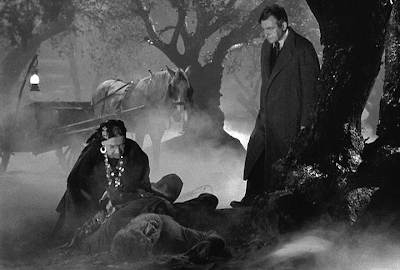
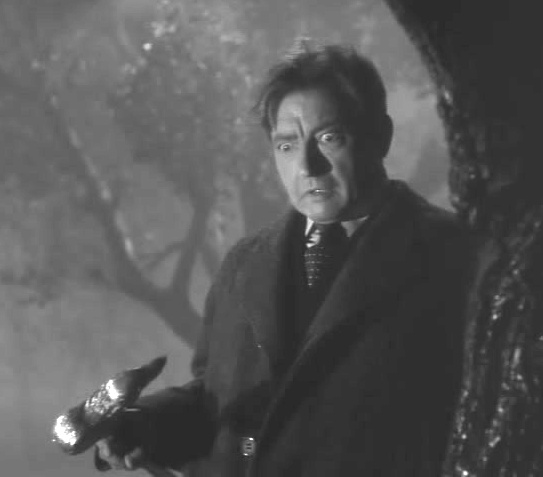
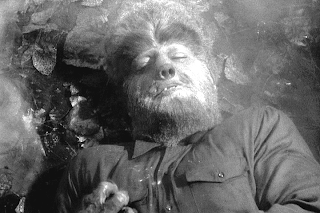
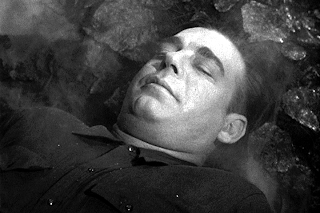
Sir John continues to beat the monster until he has no more strength left. It is then that Maleva, the gypsy woman, arrives and with her spell puts the dead man’s soul to rest…
…and changes him back to his human form. Sir John watches in horror as the face of his son is revealed, the son he has just beaten to death.
No death in any horror film up to this time has ever shown the trauma experienced by a survivor as intensely as we now see on the face of the father who killed his own son. And let me add an even more disturbing thought to what is already a very disturbing scene; is it possible that as he was killing “the monster”, Sir John knew in his heart that it was his son? This is a truly rare moment when a horror film seems to reach almost to the level of Shakespearean tragedy.